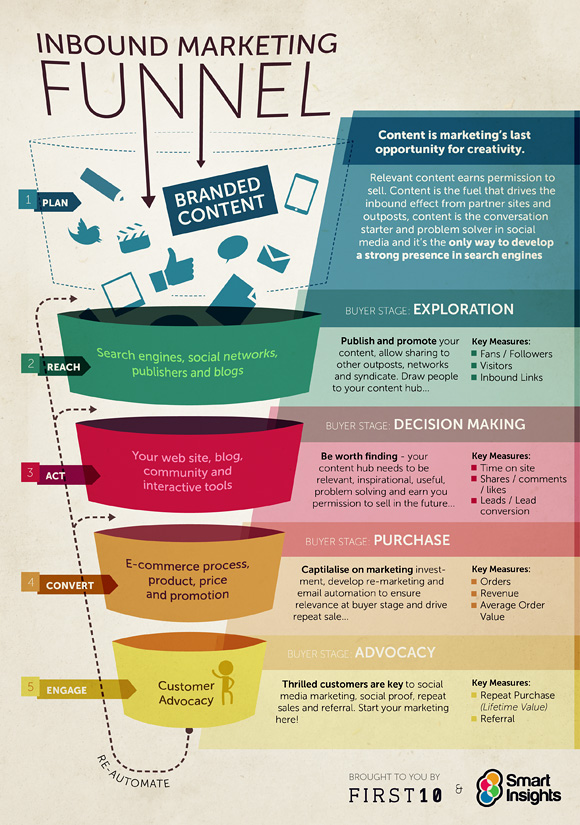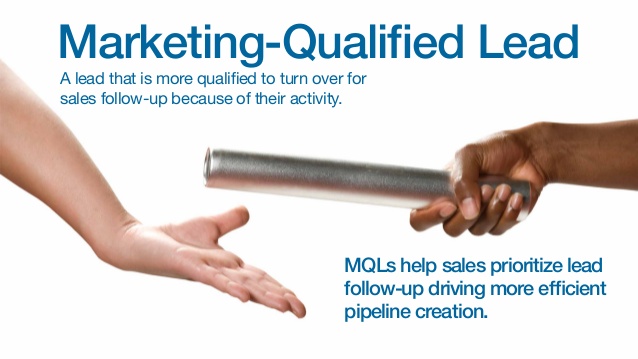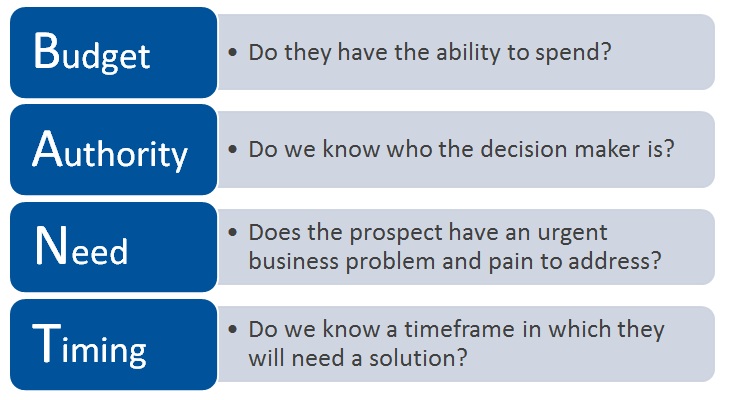How well do you understand your prospect’s behavior and expectations?
Do you know and understand the difference in behavior between your top and bottom funnel prospects? Can you accurately describe how to align your marketing for those different stages of desire and when to shift from your marketing phase into your sales phase?
I ask because a lot of marketing managers can’t. They’re not fully aware of each stage within their funnel and how it affects behavior and expectations.
Too many marketing managers take an overly simplistic view of funnel progression and prospect expectations. They attract prospects with top funnel campaigns and shift immediately into pushing for the sale. This rarely works.
Your sales funnel isn’t a two step process. There are several smaller steps and myriad interactions that should influence how you communicate with and approach your prospects, or you risk increasing the leaks in your sales funnel.
This is where the majority of businesses fall flat. They don’t take into consideration these little interactions, the actions that should change how you approach and interact with your customers.
Maintaining a profitable sales funnel is actually an incredibly sensitive operation. Push too soon and you’re seen as too aggressive and will lose the prospect, leave it too late and you’re likely going to get beaten to the punch by a competitor.
To keep things ticking over as they should, you need to implement some form of sophisticated lead tracking. Something which not only tracks and analyses all the minor actions your prospect’s take, but does so in a manner that tells you when it’s time to switch your approach and pursue the sale.
I’ll be covering how you can implement such a campaign later in the article, but before we get onto how to implement this kind of campaign you need to understand the two overarching stages your prospects will pass through.
These two stages are marketing qualified leads (MQL) and sales qualified leads (SQL).
So let’s put the confusion to rest and first look at defining the two.
What is a Marketing Qualified Lead?
In a sentence, a marketing qualified lead is a prospect who has demonstrated an interest in your product or service; they’re not yet ready to purchase, but are open to the possibility of doing so.
While the above is a good generalization of what makes an MQL, it glosses over key criteria. Mainly, what exactly constitutes ‘interest’.
Interest is a difficult metric to measure, and it’s certainly going to differ from business to business. You’ll need to examine your historical analytics data and discover which actions eventually led to a purchase.
However, to help get you off to a good start below are listed a couple of the more common indicators of interest:
– Completing an online form
– Downloaded content
– Signed up for a newsletter
– Placed items in a shopping cart
– More sophisticated campaigns can even track browsing habits to determine intent
Don’t assume that a prospect who exhibits the above are ready for a purchase.
None of the above guarantee a sale. That’s the first thing you’ve got to realize with MQLs.
There’s no guarantee, but these indicators do isolate a small portion of your prospective customer base and highlight them as being more engaged and thus more receptive to a sales pitch.
Think of it as the first stage of sorting the wheat from the chaff. Let’s move on to the next stage.
What is a Sales Qualified Lead?
It’s basically the next stage in your prospect’s journey from lead to customer.
An SQL has demonstrated a keen interest in the services and products you offer. They’re the guys who are downloading multiple pieces of content, have signed up to every newsletter you run and are consistently engaged with your brand.
The deciding factor for an SQL is whether they fit your ideal customer personae. You might have some enthusiastic readers and interest parties who aren’t in a position that needs to purchase your product. You need to ensure that the people you reach out to aren’t just engaged, but actually have a need for the product.
Simply put, the difference between a marketing qualified and sales qualified lead lies in the readiness to purchase. An SQL is just an MQL, who’s ready and has a need to purchase right now.
When do Leads Transition?
This is the million dollar question.
Marketing’s job is to fill your pipeline with as many targeted leads as possible. Sales need to convert these lead into paying customers. But when does a lead transfer from one department to the next? What is it that makes sure the lead that’s passed over is ready for a little one on one time with the sales team?
And this is where the water gets cloudy.
If you asked ten different businesses, you’d get ten different answers. Hell, if you asked the sales and marketing teams in one business you’d probably get different answers.
Having full integration between your marketing and sales departments is a tall order for any business. Marketing will always blame sales for missing out on conversion opportunities. Sales, of course, will always cover their own asses and blame their lack of conversions on poor quality leads.
So, what can you do?
Not all of your leads are going to be perfect specimens for you to pursue a conversion. In fact, if you’ve ever implemented any sales funnel you’ll know that there’s a huge churn rate at every stage.
You need to know how engaged a lead needs to be before marketing hands it off to sales. The only viable method of doing so is with a comprehensive lead scoring system.
If you’ve not heard of a lead scoring system before, don’t worry, it’s exactly what it sounds like; a method of measuring the engagement of each prospect to assign them a score. A score which, in time, will dictate which department handles the next step.
Let’s put it in real terms.
You’ve two leads. The first has voraciously devoured every single piece of marketing material you’ve published and is a regular visitor to your website. The second, whilst being a regular visitor, hasn’t yet downloaded any materials related to your product, the problem it solves or the industry in general.
The initial assumption with the above is to think that lead one is the one you hand off to sales. Easy, right? Actually, it’s not. Yes, the interactions each lead has with your site will heavily influence their score and the way you handle them. But there’s more to lead scoring than that.
After inspecting the leads, you realize that lead one is in a very junior position. Despite their voracious appetite for information, they’re not going to be in a position to influence the purchase of your product for at least another five years.
Lead two, on the other hand, is the ‘senior VP of purchasing your product decisions’. They’re not as engaged, but are the exact person you need to be targeting with your marketing.
So what should you do?
Well, this is where your lead scores come into effect. You’ll want to get your sales and marketing teams together to assign scores to different user actions and roles to help you identify who is a good fit for your product.
Below I’ve created a very simple example based the above two leads and the actions they both might have taken.
| Score | Lead One | Lead Two | |
| Job Role | 2 | 15 | |
| Site Visits | 2 | (X 3) = 6 | X 4 = 8 |
| Info Product Downloads | 3 | (X 3) = 9 | 0 |
| TOTAL | 17 | 23 |
This has leveled the playing field somewhat. Prospect one, who at a glance was far and away the best prospect to pursue, is now lagging behind, primarily because s/he’s in the wrong job role and wouldn’t be able to purchase your product even if they wanted to.
The above of course is an over-simplified example, but it serves to demonstrate the need for comprehensive lead scoring. You’ll want to score leads based on all kinds of behavior including site visits and engagement, downloads, email opens and even their historical behaviors and purchase decisions.
Each activity needs to have its own assigned value. Values will be determined on your historical data but will also need to stay fluid. As time goes by you’ll notice different trends and behaviors emerging that will require you to adjust your process.
You’ll also need to consider your different product ranges. The download of a white paper on attracting traffic for top of funnel stages should contribute more to a funnel optimization service than to an account based marketing service.
Your sales and marketing teams will have to spend a good deal of time discussing the various points and deciding which actions are more important and contribute more to the lead score.
Their final job will be to decide on a threshold which indicates when a lead has demonstrated enough interest to warrant them being passed over to the sales team as a fully bonafide sales qualified lead.
The Inevitable Gap
There seems to be some unwritten rule of the natural world that prevents sales and marketing from ever working together harmoniously for prolonged periods of time.
This isn’t exactly news, but it could undermine the hard work you’ve put into establishing your lead scoring system if left uncontrolled.
To keep your lead scoring system up to date and the transition of a lead from marketing to sales timely, you’re going to need everyone to get and stay on the same page.
There’s a few ways to achieve this:
1 – Hold regular meetings and strategy sessions with both departments. Be sure to cover everything from what’s going well and what isn’t to any changes either department thinks would be beneficial to the overall strategy.
2 – Enforce a closer working relationship between the two. I’m not talking a forced sharing of duties or even integrating one department into another. This could be as simple as having both departments situated closer to one another in the office allowing for real time feedback and advice from one to the other.
3 – Implement an account based marketing campaign. ABM has come a long way in recent years and is now available to businesses of any size. It’s one of the few marketing campaigns that requires consistent input from both sales and marketing, resulting in the two constantly working together and striving towards a common goal instead of competing with one another and jeopardizing your campaign.
There’s always going to be a gap between your sales and marketing teams. If left unmonitored that gap could grow to a point where it threatens the lead scoring system you’ve implemented.
It doesn’t take much to ensure everyone’s always working towards a common goal, be sure to set out your strategy for keeping everyone working together at the start of your campaign.
Knowing the Difference Could Help Skyrocket Your Conversions
Knowing the difference between marking and sales qualified leads is only half the equation. To turn a good conversion rate into a great conversion rate, you need to also know how to properly score your leads so you can identify when one transitions from a marketing lead to a sales lead.
As with any marketing method, this isn’t a case of set it and forget it. The lead scoring strategy you employ is going to require constant monitoring and tweaking.
If you fail to keep a close eye on your campaign, you’ll find yourself quickly falling back into the dangerous territory of not differentiating between marketing and sales qualified leads which of course leads to confusion, conflict, and crappy conversions.









